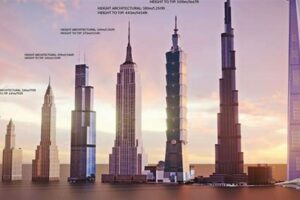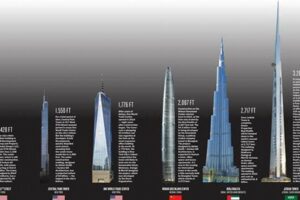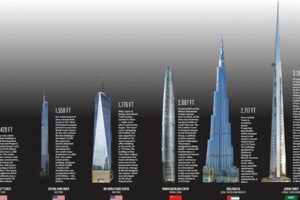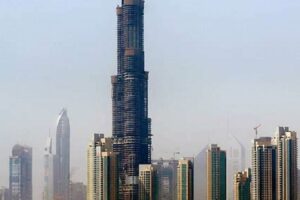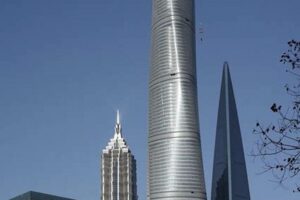The tallest skyscraper in New York is One World Trade Center, standing at 1,776 feet tall. The building was completed in 2014 and serves as a replacement for the original World Trade Center towers, which were destroyed in the 9/11 attacks. One World Trade Center is a symbol of resilience and strength for the city of New York and is one of the most iconic buildings in the world.
The building is also a major tourist destination, with visitors coming from all over the world to see the stunning views from the observation deck. The deck offers 360-degree views of the city and is a great way to get a sense of the scale of New York City.
In addition to its symbolic and tourist value, One World Trade Center is also a major business center. The building is home to a number of large corporations, including Cond Nast, Google, and Bank of America. The building’s location in the heart of the Financial District makes it a convenient place for businesses to operate.
1. Height
The height of One World Trade Center is a defining characteristic that sets it apart as the tallest skyscraper in New York and the Western Hemisphere. This exceptional height holds significant implications for the building’s design, functionality, and symbolic importance.
- Architectural Prowess: Achieving such an extraordinary height required innovative engineering and construction techniques. The building’s strong foundation and advanced structural system allow it to withstand high winds and seismic activity, ensuring its stability and safety.
- Panoramic Views: The height of One World Trade Center offers breathtaking panoramic vistas of New York City and beyond. Its observation deck, the One World Observatory, provides visitors with unparalleled 360-degree views, stretching for miles in every direction.
- Urban Landmark: The sheer height of the building makes it a prominent landmark on the New York City skyline. Its distinctive spire can be seen from various vantage points throughout the city, serving as a beacon of architectural achievement and urban pride.
- Height as Symbolism: The height of One World Trade Center holds symbolic significance, representing the resilience and determination of the city after the 9/11 attacks. Its elevation to 1,776 feet, the year the United States Declaration of Independence was signed, further emphasizes this symbolic connection.
In conclusion, the height of One World Trade Center is an integral aspect of its identity as the tallest skyscraper in New York and the Western Hemisphere. It showcases architectural innovation, provides unparalleled views, serves as an iconic landmark, and embodies the spirit of resilience and progress.
2. Symbolism
The symbolism embedded in One World Trade Center, as a replacement for the original towers, is deeply intertwined with the identity of “the tallest skyscraper in New York.” It carries profound meanings that transcend its architectural grandeur and physical presence.
- Resilience and Rebirth: The construction of One World Trade Center on the site of the former Twin Towers serves as a powerful symbol of resilience and the city’s ability to rise above adversity. It represents New York’s unwavering spirit and its determination to rebuild and thrive after the tragic events of 9/11.
- Memorial and Remembrance: One World Trade Center incorporates several elements that honor the victims of the 9/11 attacks and serve as a place of remembrance. The building’s footprint aligns with the original towers, and its height of 1,776 feet symbolically references the year the United States Declaration of Independence was signed, evoking themes of freedom, strength, and renewal.
- Hope and Inspiration: The sheer height of One World Trade Center, reaching towards the sky, symbolizes hope and the aspiration to move forward. It inspires a sense of optimism and determination, reminding New Yorkers and visitors alike of the city’s ability to overcome challenges and strive for a brighter future.
- Architectural Legacy: One World Trade Center stands as a testament to the resilience and innovation of human architecture. Its design incorporates advanced engineering techniques and sustainable features, showcasing the city’s commitment to progress and innovation while honoring its past.
In conclusion, the symbolism embedded in “the tallest skyscraper in New York” extends beyond its physical attributes. It embodies the city’s indomitable spirit, its ability to overcome adversity, and its unwavering commitment to hope and renewal. One World Trade Center serves as a powerful symbol of resilience, remembrance, and architectural achievement, inspiring and motivating generations to come.
3. Architecture
The architectural design of “the tallest skyscraper in New York” plays a crucial role in its overall identity and significance. Conceptualized by Skidmore, Owings & Merrill, the building showcases a sleek, modern design with an impressive glass facade, contributing to its iconic status and functionality.
- Innovative Structural Engineering: The skyscraper’s design incorporates innovative structural engineering techniques to achieve its extraordinary height while ensuring stability and resilience against various environmental forces. This advanced engineering allows the building to withstand high winds and seismic activity, prioritizing safety and longevity.
- Sustainable Features: The glass facade of the skyscraper is not merely an aesthetic choice but also serves functional purposes. The facade incorporates energy-efficient glazing, reducing heat gain and promoting natural light penetration. This sustainable design contributes to the building’s LEED Gold certification, demonstrating its commitment to environmental responsibility.
- Aesthetic Appeal: The sleek, modern design of the skyscraper complements the New York City skyline, adding a contemporary touch to the iconic cityscape. Its glass facade reflects the surrounding buildings and the sky, creating a dynamic and visually appealing exterior that enhances the overall aesthetic of the city.
- Functional Advantages: The glass facade provides ample natural light, reducing the need for artificial lighting and creating a more comfortable and productive indoor environment for occupants. Additionally, the facade offers panoramic views of the city, enhancing the experience for visitors and tenants alike.
In conclusion, the architecture of “the tallest skyscraper in New York” is not ju
st about aesthetics but also encompasses innovative engineering, sustainability, and functionality. Its sleek, modern design with a glass facade contributes to the building’s iconic status, environmental consciousness, visual appeal, and overall functionality, making it a remarkable addition to the architectural landscape of New York City.
4. Observation Deck
The observation deck, known as the One World Observatory, is an integral component of “the tallest skyscraper in New York,” providing visitors with an unparalleled experience and contributing to the building’s overall significance.
As the tallest skyscraper, the building offers an unparalleled vantage point, allowing visitors to enjoy breathtaking 360-degree views of the city from its observation deck. This unique feature attracts millions of tourists annually, making it a major tourist destination and an iconic landmark.
The observation deck serves as a platform for visitors to witness the city’s vastness and vibrant energy. It offers panoramic views that stretch for miles, showcasing iconic landmarks, the intricate urban fabric, and the surrounding natural beauty. The experience of being atop the tallest skyscraper, coupled with the breathtaking views, creates a lasting impression on visitors, solidifying the building’s status as a must-visit destination.
Moreover, the observation deck contributes to the economic vitality of the city. It generates revenue through ticket sales and attracts tourists who spend money on other local businesses, such as restaurants, hotels, and transportation services. The presence of the observation deck enhances the overall tourism industry and supports local businesses.
In conclusion, the observation deck of “the tallest skyscraper in New York” is not merely an amenity but an essential component that elevates the building’s significance. It offers breathtaking views, attracts tourists, and contributes to the city’s economy. The observation deck, combined with the building’s height and architectural prowess, makes it a true icon and a symbol of New York City’s resilience and vibrancy.
5. Business Center
The presence of a business center within “the tallest skyscraper in New York” is not merely coincidental; it is a strategic move that underscores the building’s significance as a hub for finance and commerce. The combination of height and business center creates a synergistic relationship that elevates the building’s status and contributes to the city’s economic vitality.
The height of the building, reaching towards the sky, commands attention and conveys a sense of power and prestige. This symbolic stature attracts prominent corporations, particularly those in the finance and commerce sectors, who seek to establish their presence in a location that exudes success and ambition. The concentration of Fortune 500 companies within the building creates a dynamic business ecosystem, fostering collaboration, innovation, and economic growth.
The practical advantages of having a business center in the tallest skyscraper are numerous. The building’s central location in the heart of the financial district provides convenient access to transportation, amenities, and other businesses. The state-of-the-art infrastructure, including high-speed elevators, advanced communication systems, and modern office spaces, ensures efficient operations and productivity for tenants.
Furthermore, the observation deck, with its breathtaking views of the city, serves as an exclusive venue for business meetings, conferences, and networking events. This unique feature provides tenants with the opportunity to host clients and partners in an impressive and memorable setting, enhancing their business relationships and reputation.
In conclusion, the business center within “the tallest skyscraper in New York” is not just an amenity but an integral component that reinforces the building’s status as a major hub for finance and commerce. The combination of height, location, infrastructure, and amenities creates an environment that attracts leading corporations, fosters business growth, and contributes to the economic vitality of the city.
6. Sustainability
The pursuit of sustainability in “the tallest skyscraper in New York” is not merely a trend but a testament to the building’s commitment to environmental responsibility. Achieving LEED Gold certification signifies its adherence to rigorous green building standards, resulting in a structure that minimizes environmental impact while promoting occupant well-being.
- Energy Efficiency: The skyscraper incorporates energy-efficient lighting systems, HVAC systems, and appliances, reducing its overall energy consumption. This not only lowers operating costs but also contributes to mitigating greenhouse gas emissions, aligning with the city’s sustainability goals.
- Water Conservation: Water-saving fixtures and appliances are installed throughout the building, promoting responsible water use. Advanced irrigation systems optimize water usage in landscaping, further reducing the building’s environmental footprint.
- Material Selection: The use of sustainable materials, such as recycled steel and low-VOC paints, minimizes the building’s embodied carbon and promotes healthier indoor air quality for occupants.
- Waste Management: Comprehensive waste management programs are implemented to reduce, reuse, and recycle waste generated by the building’s occupants. This contributes to diverting waste from landfills and conserving natural resources.
The commitment to sustainability in “the tallest skyscraper in New York” extends beyond environmental benefits. It also enhances the building’s overall value and appeal to tenants and visitors alike. By embracing green building practices, the building aligns with the growing demand for sustainable and healthy spaces, positioning itself as a responsible and forward-thinking addition to the city’s skyline.
7. Tourism
The allure of “the tallest skyscraper in New York” as a popular tourist destination stems from its iconic status and the unique experiences it offers. Its extraordinary height, captivating architecture, and symbolic significance make it a must-visit attraction for tourists from around the world.
The observation deck, situated at the pinnacle of the skyscraper, is a major draw for tourists. It provides breathtaking panoramic views of the city, allowing visitors to witness the vastness and vibrancy of New York City from above. The experience of ascending to the observation deck, often involving high-speed elevators and interactive exhibits, adds to the overall appeal.
Furthermore, the skyscraper’s architectural design and its status as an engineering marvel attract tourists interested in modern architecture and urban planning. Its sleek facade, innovative structural systems, and sustainable features serve as a tes
tament to human ingenuity and the advancements in skyscraper design.
The practical significance of understanding the connection between tourism and “the tallest skyscraper in New York” lies in maximizing its potential as an economic driver and cultural landmark. By catering to the needs and interests of tourists, businesses and organizations associated with the skyscraper can enhance the visitor experience and generate revenue.
In conclusion, “the tallest skyscraper in New York” serves as a powerful magnet for tourists, attracting millions of visitors annually. Its iconic status, breathtaking observation deck, and architectural significance contribute to its popularity as a tourist destination. Recognizing and leveraging this connection can help optimize the economic and cultural benefits associated with this remarkable skyscraper.
8. Icon
The iconic status of One World Trade Center, inextricably linked to its distinction as “the tallest skyscraper in New York,” solidifies its significance as a cultural and architectural symbol. This iconic status extends beyond its physical presence, deeply embedded in the collective consciousness and identity of New York City.
- Symbol of Resilience: As a replacement for the original World Trade Center towers, One World Trade Center carries immense symbolic weight, representing the city’s resilience and unwavering spirit in the face of adversity. Its height and grandeur serve as a powerful testament to the indomitable nature of New Yorkers and their ability to rise above challenges.
- Architectural Marvel: The skyscraper’s innovative design and engineering prowess contribute to its iconic status. Its sleek facade, soaring height, and sustainable features make it an architectural marvel that captures the imagination of visitors and locals alike. One World Trade Center stands as a symbol of human ingenuity and the continuous evolution of skyscraper design.
- Cultural Symbol: The skyscraper’s iconic status is deeply intertwined with the cultural fabric of New York City. Its image is synonymous with the city’s skyline, appearing in countless movies, television shows, and works of art. One World Trade Center has become a cultural touchstone, representing the aspirations, dreams, and energy that define New York City.
- Tourist Destination: The iconic status of One World Trade Center attracts tourists from around the world. Its observation deck offers breathtaking panoramic views, making it a must-visit destination for visitors seeking to experience the grandeur of New York City from above. The skyscraper’s iconic status contributes to its popularity as a tourist attraction, generating revenue and supporting the local economy.
In conclusion, the iconic status of One World Trade Center is inextricably linked to its distinction as “the tallest skyscraper in New York.” It serves as a symbol of resilience, an architectural marvel, a cultural touchstone, and a major tourist destination. Understanding this connection provides valuable insights into the skyscraper’s cultural significance, economic impact, and enduring legacy in the heart of New York City.
FAQs about “the tallest skyscraper in New York”
This section addresses frequently asked questions and misconceptions surrounding “the tallest skyscraper in New York,” providing informative answers to enhance your understanding.
Question 1: What is the official name of the tallest skyscraper in New York?
Answer: One World Trade Center.
Question 2: How tall is One World Trade Center?
Answer: 1,776 feet (541 meters) tall.
Question 3: When was One World Trade Center built?
Answer: Completed in 2014.
Question 4: How many floors does One World Trade Center have?
Answer: 110 floors above ground and 5 below ground.
Question 5: What is the purpose of One World Trade Center?
Answer: Primarily serves as a commercial office space, housing various businesses and organizations.
Question 6: Is it possible to visit the top of One World Trade Center?
Answer: Yes, visitors can purchase tickets to access the One World Observatory, located at the top of the building, which offers panoramic views of New York City.
Summary of key takeaways or final thought:
One World Trade Center stands as a symbol of resilience, architectural innovation, and economic vitality in New York City. Its iconic status and popularity among tourists make it a significant landmark and a testament to the city’s enduring spirit.
Transition to the next article section:
Continue reading to explore the architectural details, sustainability features, and cultural significance of “the tallest skyscraper in New York” in greater depth.
Tips for Visiting “the tallest skyscraper in New York”
Visiting “the tallest skyscraper in New York” can be an unforgettable experience. Here are some tips to help you make the most of your visit:
Tip 1: Purchase tickets in advance:
Tickets to the One World Observatory, located at the top of the skyscraper, are available online and on-site. Purchasing tickets in advance is recommended to avoid long lines, especially during peak season.
Tip 2: Arrive early:
Allow ample time to go through security and ascend to the observation deck. Arriving early will give you more time to enjoy the views and explore the exhibits.
Tip 3: Choose a clear day:
For the best views, visit on a clear day with good visibility. This will allow you to see for miles and capture stunning photos.
Tip 4: Take your time:
Once at the observation deck, take your time to soak in the views from different angles. Use the provided binoculars to enhance your experience.
Tip 5: Visit during sunset:
Witnessing the sunset from the observation deck is a breathtaking experience. The changing colors of the sky and the city lights create a magical ambiance.
Tip 6: Consider a guided tour:
Guided tours are available for an additional fee. They provide insights into the building’s history, architecture, and engineering, enhancing your understanding and appreciation.
Summary of key takeaways or benefits:
By following these tips, you can maximize your visit to “the tallest skyscraper in New York,” ensuring a memorable and enriching experience.
Transition to the article’s conclusion:
Prepare to be awestruck by the panoramic views, innovative architecture, and symbolic significance of “the tallest skyscraper in New York.” Your visit will leave a lasting impression, providing a deeper appreciation for the city’s resilience, ambition, and architectural prowess.
Conclusion
One World Trade Center, standing as “the tallest skyscraper in New York,” embodies the city’s indomitable spirit, architectural ingenuity, and economic vitality. Its height and iconic status symbolize resilience, innovation, and the continuous evolution of New York City.
The skyscraper’s commitment to sustainability reflects its responsible approach to the environment and well-being of its occupants. Its popularity among tourists showcases its cultural significance and serves as a major attraction for visitors from around the globe.
As a symbol of resilience and progress, One World Trade Cen
ter continues to inspire and captivate. It stands as a testament to the human ability to overcome adversity and reach for new heights. Whether admired from afar or experienced firsthand, “the tallest skyscraper in New York” remains a powerful and enduring symbol of the city’s indomitable spirit.


